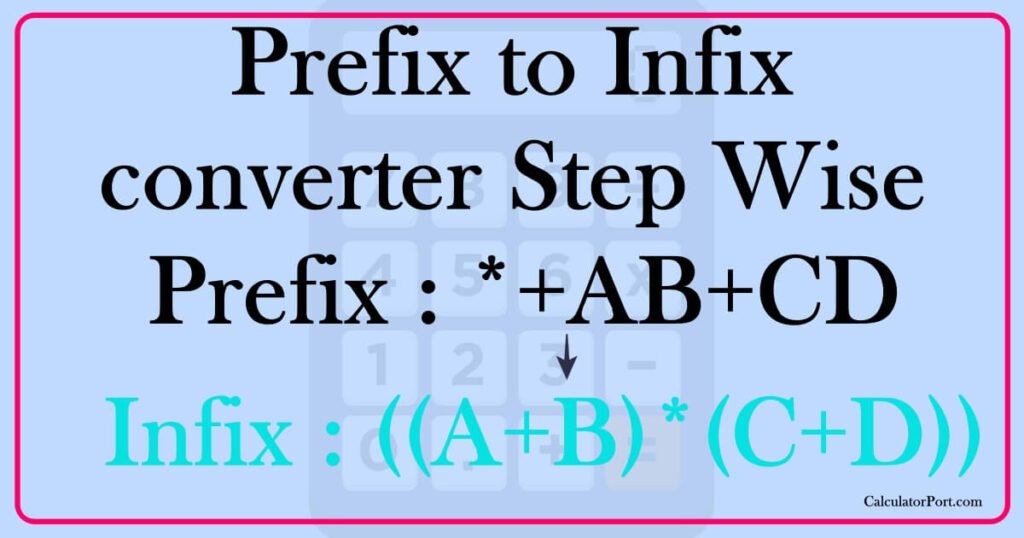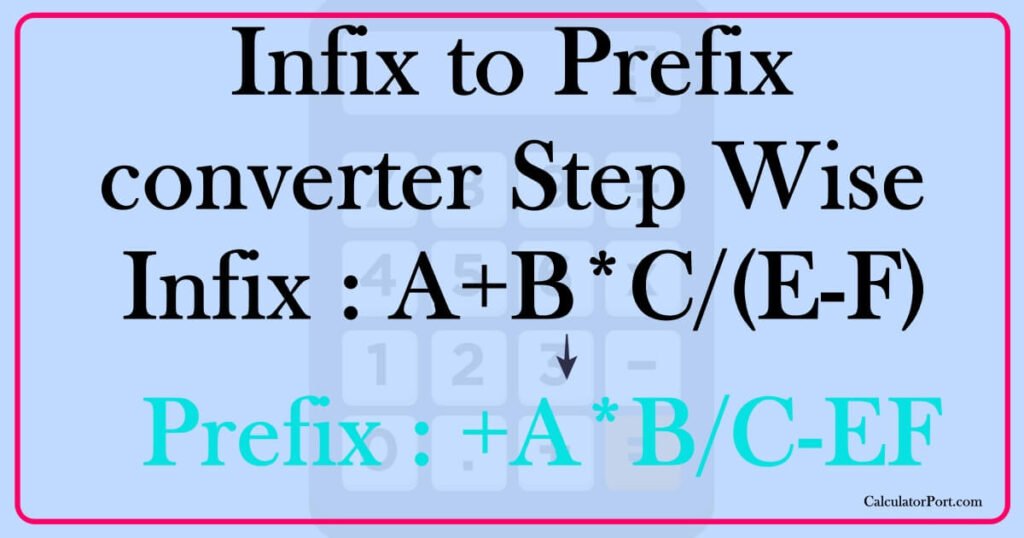Postfix to infix converter
Postfix:
Infix:
| Input String | Postfix Expression | Stack (Infix) |
|---|
A postfix expression is a type of arithmetic expression in which the operands (numbers) are written before the operator symbols. For example, the postfix expression “2 3 +” means “add 2 and 3.”
On the other hand, an infix expression is a type of arithmetic expression that is written using the standard notation for operators (e.g. “*” for multiplication, “+” for addition). The same expression “2 3 +” would be written as “2 + 3” in infix notation.
To convert a postfix expression to an infix expression, you can use the following steps:
- Create an empty stack
- Start scanning the postfix expression from left to right
- If the current character is an operand, push it onto the stack
- If the current character is an operator, pop two operands from the stack, put the operator between them, and push the result back onto the stack
- Repeat steps 2-4 until you have scanned the entire expression
- The result will be the top element on the stack, which is the infix expression
In the realm of computer science and programming, understanding different notations for expressions is crucial. Among these notations, postfix (or Reverse Polish Notation) and infix are commonly used. This article will delve into the conversion from postfix to infix, exploring various aspects including algorithms, examples, and implementations in C.
What is Postfix and Infix Notation?
Before diving into the conversion process, let’s briefly define postfix and infix notation.
- Infix Notation: This is the conventional notation that we use in arithmetic expressions, where operators are placed between operands. For example, the expression “A + B” is in infix form.
- Postfix Notation: In this notation, operators follow their operands. The same expression “A + B” would be represented as “A B +”. This format eliminates the need for parentheses to dictate operation precedence.
The Importance of Postfix to Infix Conversion
Converting from postfix to infix is essential for situations where readability and traditional mathematical expression formats are required. This is particularly useful in compilers and interpreters that need to evaluate expressions in a human-readable format.
Postfix to Infix Calculator
A postfix to infix calculator is a tool that helps in converting postfix expressions to infix. This can be implemented using a stack data structure, which is key to the conversion process.
Algorithm for Postfix to Infix Conversion Using Stack
The algorithm for converting postfix to infix using a stack is as follows:
- Initialize an empty stack.
- Scan the postfix expression from left to right.
- For each token:
- If the token is an operand, push it onto the stack.
- If the token is an operator:
- Pop the top two elements from the stack (let’s call them
operand1andoperand2). - Form a new string by combining
operand2, the operator, andoperand1in infix format:"(operand2 operator operand1)". - Push this new string back onto the stack.
- After processing all tokens, the final element in the stack will be the complete infix expression.
Postfix to Infix Example
Let’s consider a simple example of converting a postfix expression to infix:
Postfix Expression: AB+C*
Conversion Steps:
- Read
A(operand), push to stack: Stack = [A] - Read
B(operand), push to stack: Stack = [A, B] - Read
+(operator), popBandA, form(A + B), push to stack: Stack = [(A + B)] - Read
C(operand), push to stack: Stack = [(A + B), C] - Read
*(operator), popCand(A + B), form((A + B) * C), push to stack: Stack = [((A + B) * C)]
Final Infix Expression: ((A + B) * C)
Postfix to Infix Code in C
Here’s a simple implementation of the postfix to infix conversion algorithm in C:
#include <stdio.h>
#include <stdlib.h>
#include <string.h>
#include <ctype.h>
#define MAX 100
char stack[MAX][MAX];
int top = -1;
void push(char *item) {
if (top < MAX - 1) {
top++;
strcpy(stack[top], item);
}
}
char* pop() {
if (top >= 0) {
return stack[top--];
}
return NULL;
}
int isOperator(char ch) {
return (ch == '+' || ch == '-' || ch == '*' || ch == '/');
}
void postfixToInfix(char *postfix) {
char *token;
char operand1[MAX], operand2[MAX], temp[MAX];
token = strtok(postfix, " ");
while (token != NULL) {
if (isalnum(token[0])) {
push(token);
} else if (isOperator(token[0])) {
strcpy(operand1, pop());
strcpy(operand2, pop());
sprintf(temp, "(%s %c %s)", operand2, token[0], operand1);
push(temp);
}
token = strtok(NULL, " ");
}
printf("Infix Expression: %s\n", pop());
}
int main() {
char postfix[] = "A B + C *";
postfixToInfix(postfix);
return 0;
}
Time Complexity of Postfix to Infix Conversion
The time complexity for converting postfix to infix is O(n), where n is the number of tokens in the postfix expression. This efficiency is due to the single pass through the expression and the constant-time operations associated with stack manipulation.
Infix to Postfix and Prefix Questions
Understanding the differences between infix to postfix and infix to prefix conversions is crucial for mastering expression evaluation. Here are some key points:
- Infix to Postfix: This conversion involves rearranging the operators and operands while respecting operator precedence and associativity. It is commonly used in compilers.
- Infix to Prefix: Similar to postfix, this conversion also respects operator precedence but places operators before their operands.
Infix to Postfix Examples with Answers
- Infix:
A + B * C
- Postfix:
A B C * +
- Infix:
(A + B) * C
- Postfix:
A B + C *
Difference Between Infix to Postfix and Infix to Prefix
The main difference lies in the positioning of operators:
- In postfix, operators come after their operands.
- In prefix, operators are placed before their operands.
Conclusion
The conversion from postfix to infix is a fundamental concept in computer science, especially in the context of expression parsing and evaluation. By utilizing stacks and understanding the underlying algorithms, programmers can effectively manage expressions in various notations. Whether you’re implementing a postfix to infix converter in C or tackling infix to postfix questions, a solid grasp of these concepts will enhance your programming skills and comprehension of data structures.


